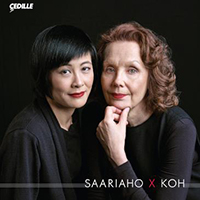Music Web International
By Gary Higginson
January 20, 2019
original link
Saariaho X Koh Review
Kaija SAARIAHO (b.1952)
Tocar for Violin and piano (2010) [6.51]
Cloud Trio for string trio (2009) [13.30]
Light and Matter for Violin, cello and piano (2014) [13.53]
Aure: version for violin and cello (2011) [5.47]
Graal théâtre (1994) [27.40]
Jennifer Koh (violin)
Nicholas Hodges (piano)
Hsin-Yun Huang (viola)
Wilhelmina Smith, Anssi Kartunen (cello)
Curtis 20/21 Ensemble/Connor Gray Covington
rec. 2016/17, The Curtis School of Music; Academy of Arts and Letters, New York; Studios Ferber, Paris
CEDILLE RECORDS CDR90000183 [68.06]
This disc is a very good example of what can happen when a leading modern composer links in with some of the finest of our young(ish) musicians with a particular calling to perform and record challenging contemporary music. The highlighted performer here is Jennifer Koh but she has a wonderful support team.
When Koh first heard Saariaho’s music she knew “immediately that this was someone she related to” (programme notes by Anne Lellehua Lazilotti). Koh in fact became a known name due to her ‘Bach and Beyond’ and ‘Two X four series’ recorded also by Cedille Records. She was also given the title ‘Musical America’s 2016 Instrumentalist of the Year.’ Nicholas Hodges is an extraordinarily intelligent and virtuosic performer devoting himself to some of the most exacting of contemporary composers like, for example, Elliot Carter. High praise is also given to cellists Anssi Marttunene and Wilhelmina Smith and viola player Hsin-Yun Huang. And this is just what Saariaho’s music needs; that is - young performers who are willing to take risks, have the finest of techniques, and tackle music that only repays in time.
Tocar for violin and piano came about because the composer was trying to get the performers to touch musically so she is quoted as saying “ the instrumentalists move forward independently, but also keep an eye on each other”. It’s a concept that can apply to any music, of course, but here the intersecting lines and cross-fertilisation of motifs have a hypnotic and sensual effect but with no beginning and no end unless the astonishing, final major sounding chord which fades away is really an ending. It could just be acting as an overture to the next work, the longer Cloud Trio for a more extended group.
This is the notoriously difficult String trio combination but you forget as you listen that it is just three string instruments. During its four movements of which only the third is quick and rhythmic (Sempre energico) one feels the air from another planet or, as the booklet remarks, one feels that the trio has a “secret existence shimmering in the dark”. That’s exactly how I feel, but it’s a northern, cold darkness not inhabited by humans and inspired, the composer admits, again by touching, that is of clouds touching, in all their myriad variety, the mountain peaks. And clouds, which you can almost “touch with your hands” (the composer’s note)
Another duet is Aure in a version for violin and cello in which a motif taken from Dutilleux’s last work ‘Shadows of Time’ is used like a “question”. which “passes back and forth” this motif as set by Dutilleux to the words ‘Why us, why the star” is sung by a child. Saariaho wrote her's in honour of the French composer’s 95th birthday and uses the motif in three ways, marked ‘calm’ then ‘intense’ then ‘fragile’ eventually flickering into harmonics. All so subtle and never overstaying its welcome.
In another single movement work Light and Matter the composer sets her mark “Time is light: the light indicates the time, gives the rhythm, influences nature” as she wrote this piano trio the view from her study was across a park in the midst of crowded New York noting the light as it changed from season to season. The material of the piece interchanging, touching (again) each instrument sometimes using uncanny sounds from the ’harmonic spectrum’. It culminates into a pure C representing an intensity of light.
These pieces act in a way as aperitifs to the main course Graal théâtre of which much has been written elsewhere. Some of you may know of the première recording of this work by the BBC Symphony Orchestra under Esa-Pekka Salonen (Sony 60817) and this new version has an amazing amount in common with it. Gidon Kremer, the dedicatee, was that first soloist but Jennifer Koh on hearing his performance felt drawn towards the work and to the composer, so says Anne Leilehua who has recently completed a biography of Saariaho. So this Violin Concerto is in two movements, a lengthy ‘Delicato’ marked especially by the feathery delicacy of the orchestration and then an ‘Impetuoso’ evident in a breathless virtuosity ending with wildly high arpeggiated harmonics. As for its title, the composer’s thoughts moved towards ‘Graal’ as in Grail (and its religious connotation) and theatre by imagining “the soloist as the main character in a play” - quoting the composer. For me, the first movement, at seventeen minutes, is too long. Kremer for what its worth knocks half a minute off Koh’s performance but despite that the movement seems to me as if it would have benefitted for being much more condensed whereas the reckless second part is riveting and tightly constructed. The title actually comes from a novel by Jacques Roubaud which inspired the composer “to think about the theatricality of performance”.
This disc is worth exploring and I feel represents the composer fairly for anyone new to her. In addition, as indicated above, we have top performers who execute these demanding scores faultlessly. Top quality recording throughout.
Copyright © Music Web International
© Jennifer Koh, All Rights Reserved. Photography by Juergen Frank. Site by ycArt design studio
